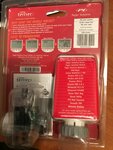- Nov 11, 2009
- 25,491
- 9,314
- 50,935
If you read my earlier post I described how I use such a system so I know how they interact.All an RF thermostat will do is turn on or off the pump depending on its setting and location. If using TRV’s. Only those rads that the TRV’s happen to have open will respond, so might even be in a different room. Room stats, fixed or otherwise, work against TRV’s.
But we don’t yet know if the OP has a system using TRV’s. It’s just an assumption.
John
But it’s not that difficult if Buckman has a TRVs in the lounge to increase the TRV setting in the lounge such that the thermostat if for example were set at 21.5 deg C it would bring the room to that temperature. The TRVs would not close off as they were set for example at maximum. Then all that’s required before going to bed would be to relocate thermostat in the hall and wind back down the TRVs. Buckman has a particular problem so perhaps a less than conventional approach might help. TRV. settings aren’t set in stone although many people never touch them from one year to the next. But if they had an electric fire they would be quite au fait with adjusting a thermostat setting on the fire to meet their needs.
The advantage of a remote RF thermostat is that it’s relative cheap, and doesn’t require access via a wifi router which some people aren’t comfortable with.
Me I’m happy with my Hive controller and standard TRVs



